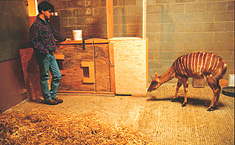The Advantages Of Training Antelope To Cooperate With Veterinary
Procedures

Temple Grandin, Ph.D., Nancy Irlbeck, Ph.D.,and Megan
Phillips
Department of Animal Sciences
Colorado State University
Fort Collins, Colorado USA 80523
Denver Zoological Gardens
Denver, Colorado USA 80205

Training animals to cooperate with veterinary procedures provides
many advantages. It provides the advantages of improved animal welfare,
reduced stress and it reduces the chance of injury to the animals. It is
also much safer for employees than forced manual restraint and helps
prevent damage which spoils the appearance of the animals, such as broken
horns. In this paper we will describe training and conditioning
procedures which have been successfully used at the Denver Zoological
Gardens to condition Tragelaphus angasi (nyala) and Tragelaphus eurycerus
(bongo) to voluntarily enter a crate for blood sampling, injections and
other veterinary procedures. These procedures are now routinely performed
on unsedated cooperative adult animals. Shipping is also much easier and
less stressful because cooperative, unsedated animals will walk into a
crate for shipping.





 Methods
Methods Treats
Treats Training Procedures
Training Procedures Habituation and Conditioning of Nyala and Bongo
Habituation and Conditioning of Nyala and Bongo Results & Disscussion
Results & Disscussion Reference List
Reference List